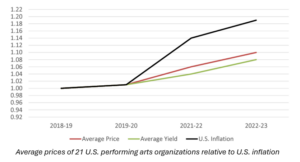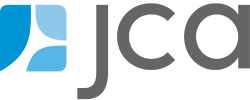In 2024, It’s All About Revenue

Jamie Alexander
Vice President, Growth and Development
This year is about recovering earned revenue.
The focus within the performing arts industry since the pandemic shut-down has mostly been on audience return—and rightfully so. Focus on revenue fell behind the need to simply get butts back in seats and revive our communities. But now the industry is in financial hardship—we’ve all seen the ever-pervasive news from the past year about layoffs and budget deficits at performing arts organizations—and we need to change tack.
It’s time to focus on revenue. While revenue in general has recovered a bit better than the size of our audiences, we still have a way to go to make up our losses and catch up with the economy. Our data shows that ticket prices have not kept pace with U.S. inflation—by far. And what’s more, we’ve also seen a lack of price sensitivity in post-pandemic audiences—both in our industry studies and our work with individual clients—so there isn’t a reason we shouldn’t be at least matching U.S. inflation with our price increases.

On the bright side, we’re already seeing positive signs that organizations have made strides in recovering revenue this season. Our research shows that revenue from ticket sales is up 20% for the first half of the 2023-24 season. The clients that we’ve seen be bolder with their revenue strategies have seen great return. These are encouraging signs that we are on the right track to returning to a place of strong earned income—we just need to place our focus on the right areas.
What can you do to ensure that your organization is maximizing earned revenue? Here’s a checklist to keep at the ready as you plan for this year:
- Optimize your starting prices. Do you know how much patrons are really willing to pay for what you offer? What programming do they value? What seats do they value? If you’re guessing, instead of basing your prices on real demand and patron values, there is a good chance you’re leaving money on the table. Also, make sure your starting prices keep pace with inflation.
- Adjust prices when things don’t go as planned. Is a show selling better than you expected? Or maybe just on Friday nights? Or just one section in one performance? Raise your prices. Are sales slower than planned? Explore your buying incentives…
- Understand your buying incentives. What incentivizes people to buy? If discounts work to put your buyers into action, are you discounting the right performances, at the right amount, to drive sales while not sacrificing revenue? Are you sending the discount offer to the right audience? Would a value-add provide the same incentive as a discount but result in higher income for the organization? Know what incentivizes your audience to maximize sales volume without sacrificing revenue.
- Re-evaluate your subscriber/member discounts. Our research shows that discounts on tickets don’t need to be steep for subscribers and members. Often, access to seats, community, and other benefits are more alluring than a steep discount. Evaluate if your subscriber discount is too steep or if there are any specific packages that are undervalued.
- Promote “upgraded” experiences. Go back to your ticket buyers, after their purchase and before their show, to promote items that will enhance their experience. Upgraded seats, pre-purchased parking spots, drinks waiting for them before the show or at intermission, VIP sections, artists talks. Upgrading after the point-of-purchase (rather than during) removes the psychological barrier of sticker shock upon initial payment.
- Review pricing of add-on purchases. What add-on purchases yield the most revenue for the organization? Push those items. What add-on purchases are expensive for the organization? Cut those. Have you factored inflation into the cost of your add-on purchases? If not, increase those prices.
- Evaluate your ancillary programming. Typically, free (or near-free) ancillary programming (such as pre-concert talks or special interest events) is developed to encourage new visitation or encourage current visitors to engage deeper. While these are important for audience engagement and development, are they actually serving to drive increased engagement and therefore increased revenue? Or are they just added work for your staff? Evaluate this closely.
- Track the right metrics. Make sure, in your revenue reporting, that you track the right metrics to evaluate your earned revenue strategy. You may be looking at overall sales for a performance, but are you looking at overall sales at each price level to identify price sensitivity or lack there-of? You may be looking at bar sales, but are you looking at bar sales relative to the costs of sale? Finding the right metrics will allow you to make the most effective decisions to optimize your revenue.
ONE IMPORTANT NOTE: Maximizing revenue does not mean foregoing practices to make your organization financially accessible to all audiences you serve. We preach Radical Pricing whenever we can and believe that it’s a vital part of your revenue strategy. At the same time we want to make sure organizations focus on making decisions that will improve their bottom lines and keep their artists and employees working.
Let’s put the gloom and doom news stories about our industry away for good in 2024. We can do it!!
We’re here to help you maximize your revenue!
JCA Arts Marketing is the industry leader in pricing and revenue management for arts and culture organizations. We’ve helped hundreds of organizations in North America increase revenue and ticket sales by leveraging data and audience insights for strategy. Got questions or need more info? Just drop us a message!

